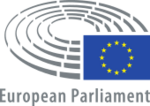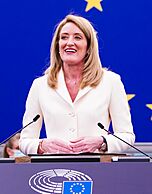President of the European Parliament facts for kids
Quick facts for kids President of the European Parliament |
|
|---|---|

|
|

Logo of the Parliament
|
|
| European Parliament | |
| Style | President |
| Member of | European Parliament |
| Residence | Louise Weiss building |
| Seat | Strasbourg, France |
| Appointer | European Parliament |
| Term length | 2.5 years, renewable once |
| Inaugural holder | Paul Henri Spaak / Robert Schuman |
| Formation | 1952 / 1958 |
| Deputy | Vice-Presidents of the European Parliament |
The President of the European Parliament is a very important leader. They guide the discussions and activities of the European Parliament. This person also represents the Parliament to the rest of the European Union (EU) and to other countries around the world. The President's signature is needed for new laws and for the EU budget to become official.
Presidents serve for two and a half years. Usually, the two biggest political groups take turns holding the position. Since the Parliament started in 1952, there have been 30 presidents. Seventeen of them have served since the first time people voted for Parliament members in 1979. So far, three women have been President. Most presidents have come from the older EU countries.
Contents
What the President Does in Parliament
The President leads debates and makes sure all Parliament activities run smoothly. They also ensure that the Parliament's rules are followed. This role is much like a speaker in a country's own parliament.
There are 14 Vice-Presidents who help the President. They lead debates when the President is not there. The President also leads meetings of the Bureau. This group handles the Parliament's money and daily operations. Another group the President leads is the Conference of Presidents. This group includes the leaders of all the Parliament's political groups.
The President's Role in the EU
The President represents the Parliament in all legal matters. They also handle the Parliament's relationships with other countries. When the European Council meets, the President speaks to them. They share the Parliament's views on the topics being discussed.
The President also takes part in big meetings about new EU treaties. Their signature is needed for the budget of the European Union and new EU laws. This is especially true for laws made through the "codecision procedure." The President also works with the Council to find agreements on these important topics.
In many countries, the head of state is the most important person in terms of official order. But in the EU, the Parliament is listed as the first institution. This means its President comes before other European or national leaders in official events. The gifts given to important visitors often depend on the President. For example, former President Josep Borrell gave visitors crystal cups. These cups had parts of the Charter of Fundamental Rights engraved on them.
After the Lisbon Treaty changed how EU leaders work, some people thought their jobs were unclear. But Ukraine's ambassador to the EU, Andriy Veselovsky, explained it well. He said the president of the European Commission is like the EU's "government." The president of the European Council is the "strategist." The High Representative handles "relations between countries." The Commissioner for Enlargement deals with technical things like trade agreements. Meanwhile, the Parliament's President talks about the EU's values. This includes supporting democratic elections in other countries.
How the President is Elected
Members of Parliament (MEPs) elect the President. They serve for two and a half years. This means there are usually two elections during each five-year Parliament term. Since the 1980s, the two main political groups, the European People's Party (EPP) and the Party of European Socialists (PES), have often agreed to share the presidency.
For example, in the 2004–2009 term, the EPP supported the PES candidate first. When that term ended in 2007, the PES supported the EPP's candidate. This usually leads to Presidents being elected with many votes. However, there have been exceptions. In the 1999–2004 term, a Liberal party member became President for the second half. This happened because of a deal between the EPP and the Liberals.
Since 2009, the outgoing President leads the election for the new President. This happens if the outgoing President is re-elected as an MEP. If not, one of the 14 Vice-Presidents takes charge. While leading the election, they have all the President's powers. But they can only focus on electing the new President.
Before the vote, candidates' names are given to the person in charge. This person then announces the names to Parliament. If no candidate gets more than half the votes after three tries, a fourth vote is held. Only the top two candidates from the previous vote can run in this final round. If there's still a tie, the oldest candidate wins.
Many famous people have been President of the Parliament. The very first President was Paul-Henri Spaak. He was one of the founding fathers of the EU. Other founding fathers like Alcide de Gasperi and Robert Schuman also served. The first two women to be President were Simone Veil in 1979 and Nicole Fontaine in 1999. Both were from France. Jerzy Buzek, a former Prime Minister of Poland, was the first President from a country that joined the EU after 1986.
Changes to the Election Process
Before 2009, the "oldest member" (the oldest MEP) would lead the election for the President. This person had all the President's duties but could only oversee the election. In 2009, the Parliament's rules changed. Now, the outgoing President (if re-elected) or a Vice-President leads the first session until a new President is chosen.
Recent Elections
2009 Election
The two main groups, the EPP and the S&D, agreed to share the presidency for the 2009–2014 term. Jerzy Buzek (EPP, Poland) was elected President for the first half of the term. He won with 555 votes against his opponent Eva-Britt Svensson (EUL-NGL, Sweden), who received 89 votes. Martin Schulz (SPD, Germany), leader of the S&D group, was expected to be elected for the second half. He was indeed elected on 17 January 2012.
2017 Election
After Martin Schulz's term ended, it was expected that an EPP member would become President. However, the agreement between the EPP and S&D seemed to be broken. This made it less certain that Antonio Tajani (EPP, Italy) would win. Other candidates included Gianni Pittella (S&D, Italy) and Guy Verhofstadt (ALDE, Belgium). On 17 January 2017, Tajani was elected after four rounds of voting. He won after Verhofstadt withdrew and supported him.
2019 Election
The election for the first half of the Ninth European Parliament term happened on 3 July 2019. David Sassoli (S&D, Italy) was elected as President in the second round of voting.
2022 Election
David Sassoli sadly passed away on 11 January 2022, just before his term ended. Roberta Metsola, who was the First Vice-President, became the acting President. The election to choose Sassoli's replacement was held as planned on 18 January 2022. The candidates were Roberta Metsola (EPP, Malta), Alice Bah Kuhnke (Greens/EFA, Sweden), and Sira Rego (The Left, Spain). Kosma Złotowski (ECR, Poland) withdrew before the vote. Metsola was elected in the first round. She received 458 votes, which was more than half of the votes. With her election, Metsola became the youngest President ever. She was also the first person from Malta to hold the office. And she was only the third female President in history.
| President of the European Parliament |
||||||||
 |
||||||||
| Roberta Metsola (EPP) of from 18 January 2022 |
||||||||
2024 Election
The election for the president of the Tenth European Parliament took place on 16 July 2024. Roberta Metsola was re-elected in the first vote. She received the most votes ever for this position.
Timeline of Presidents

Images for kids
See also
 In Spanish: Presidencia del Parlamento Europeo para niños
In Spanish: Presidencia del Parlamento Europeo para niños
- Vice-President of the European Parliament
- List of presidents of the institutions of the European Union
- President of the European Council
- President of the European Commission
- Presidency of the Council of the European Union
- President of the European Union
- Speaker (politics)


































